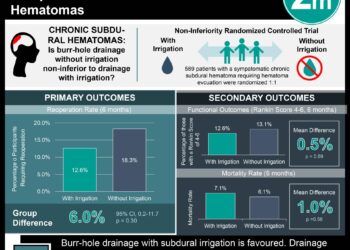Mixed outcomes from surgical evacuation of cerebellar intracerebral hemorrhage
1. In this meta-analysis, the proportion of patients with cerebellar intracerebral hemorrhage who underwent surgical evacuation and had a favorable functional outcome was not greater than those who received conservative medical treatment.
2. The proportion of patients who survived at 3 months was significantly increased among patients who received surgical hematoma evacuation.
Evidence Rating Level: 1 (Excellent)
Study Rundown: Current guidelines suggest surgical hematoma evacuation for cerebellar intracerebral hemorrhage (ICH) greater than 3cm for better functional outcomes. However, the evidence to support this claim is limited. In this systematic review and meta-analysis, surgical hematoma evacuations for found not lead to improved functional outcomes when compared to conservative medical treatment in patients with cerebellar ICH at 3 or 12 months post-ICH. However, surgical hematoma evacuation led to a higher proportion of patients who survived at 3 months.
This study has many limitations. This study included only retrospective cohort studies, and therefor has inherent limitations, such as lack of randomization and blinding. There is likely treatment bias which propensity matching cannot eliminate. The study’s ICH patients had mostly intermediate-sized hematomas, and optimal management for that sub-group of patients remains controversial.
Click to read the study in JAMA
Relevant Reading: Treatment of intracerebellar haemorrhage: Poor outcome and high long-term mortality.
In-Depth [systematic review and meta-analysis]: This was a systematic review of individual patient data and meta-analysis of 578 patients who suffered from cerebellar ICH and were treated with hematoma evacuation or conservative management. The primary outcome was proportion of patients with favorable functional outcome at 3 months defined as a modified Rankin Scale (mRS) of 0-3. Secondary outcomes were survival at 3 months, functional outcome at 12 months, and survival at 12 months. For functional outcomes at 3 months, there was not a significant difference in proportion of patients who received surgical hematoma evacuation (47/152 [30.9%]) vs those who received conservative treatment (54/152 [35.5%]; p = 0.39). Patients who received surgical hematoma evacuation had greater survival at 3 months (119/152 [78.3%]) vs those who received conservative treatment (93/152 [61.2%]; p = 0.001). The proportions of patients who achieved a favorable functional status at 12 months were similar between patients who received surgical hematoma evacuation (47/152 [30.9%]) vs those who received conservative treatment (53/152 [34.9%]; p= .46). The proportion of patients who survived at 12 months was also significantly greater in the surgical hematoma evacuation group.
Image: PD
©2019 2 Minute Medicine, Inc. All rights reserved. No works may be reproduced without expressed written consent from 2 Minute Medicine, Inc. Inquire about licensing here. No article should be construed as medical advice and is not intended as such by the authors or by 2 Minute Medicine, Inc.







